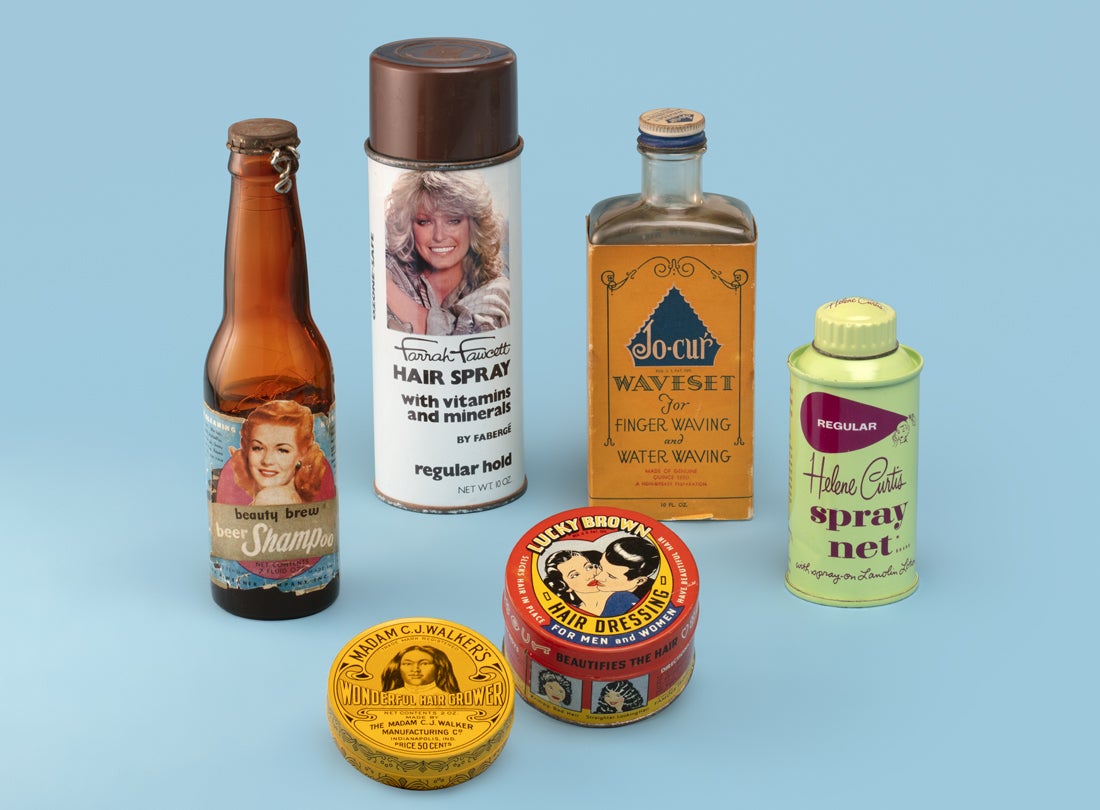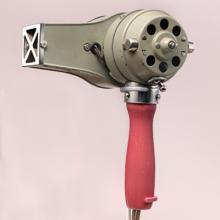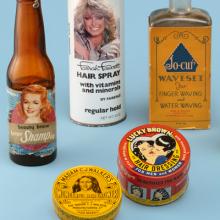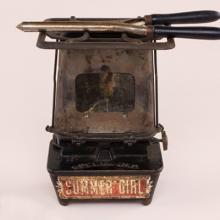Harvey Milk Terminal 1
Harvey Milk Terminal 1
Departures - Level 2
Dec 18, 2020 - Aug 22, 2021






Polar cub electric hair dryer c. 1923
The A.C. Gilbert Company
New Haven, Connecticut
L2020.0401.004a,b
Handheld electric hair dryers became available in the first decade of the twentieth century. Loud, heavy, and prohibitively expensive, early dryers operated with low wattage and required long drying times.
[clockwise from left]
Beauty Brew beer shampoo c. 1940s
Frank A. Weaner Company
Chicago
Courtesy of Jeff Hafler, Beauty Bubble Salon and Museum
L2020.0401.034
Farrah Fawcett hairspray c. 1970s
Fabergé
Hollywood, California
Courtesy of Mickey McGowan, Unknown Museum Archives
L2020.0402.008
Jo-cur Waveset c. 1920s
Affiliated Products Inc.
Jersey City, New Jersey
Courtesy of Mickey McGowan, Unknown Museum Archives
L2020.0402.005
Helene Curtis spray net c. 1959
Helene Curtis Industries
Chicago
Courtesy of Jeff Hafler, Beauty Bubble Salon and Museum
L2020.0401.042
Lucky Brown Hair Dressing 1937
Famous Products Co.
Chicago
SFO Museum
1998.098.015a,b
L2020.0406.001
Madam C. J. Walker’s Wonderful Hair Grower c. 1918
Madam C. J. Walker Manufacturing Company
Indianapolis, Indiana
Courtesy of A’Lelia Bundles
L2020.0404.001a,b
By the turn of the twentieth century, a number of hair products became available to women. In 1906, African American entrepreneur Madam C. J. Walker launched her ultra-successful Wonderful Hair Grower promising to grow hair long and strong. In the ensuing decades, women applied a setting lotion, such as Jo-cur, to create finger waves and pin curls. Hair shampoo emerged in the early twentieth century, while hairspray surfaced in the 1940s. During the 1950s, high-volume hairstyles created a greater demand for hairspray, and by the mid-1960s, hairspray became the top selling beauty product in the United States.
[left to right]
Solar electric curling iron c. 1920s
Solar Electric Mfg. Co.
San Francisco
Courtesy of Jeff Hafler, Beauty Bubble Salon and Museum
L2020.0401.052a,b
Summer Girl hair curler c. 1893
The Taylor & Boggis FDY Co.
Cleveland, Ohio
Courtesy of Jeff Hafler, Beauty Bubble Salon and Museum
L2020.0401.003
Gas-heated curling iron c. 1910s
France
Anonymous lender
L2020.0405.001
Frenchman Marcel Grateau (1852–1936) invented the “marcel wave” in 1872, which consisted of a temporary wave placed into the hair using a heated curling iron and a comb. Curling tongs were heated over gas burners; the hairdresser then tested the iron on a piece of paper before using it on their client. If the paper scorched, the iron was too hot. To create undulating waves, the hairdresser creased the hair between the blades rather than winding it around the iron. The technique remained in use well into the twentieth century.
[left to right]
Hair dryer c. 1950s
Rex-Ray
Los Angeles
Courtesy of Jeff Hafler, Beauty Bubble Salon and Museum
L2020.0401.030
Hair dryer c. 1950s
Kenmore
Courtesy of Jeff Hafler, Beauty Bubble Salon and Museum
L2020.0401.029
Rose Evansky, a Polish Jew who fled to Britain from Nazi Germany, pioneered the “blow wave” in the early 1960s in London. The ingenious styling technique freed clients from having to sit under bulbous, hot dryers with their hair set tightly in curlers. After passing by a barbershop and viewing a barber dry the front of a man’s hair with a handheld dryer and brush, she thought she would try the same on her female clients. She began rolling sections of wet hair around the brush and drying them with a handheld dryer. The new, soft “blow wave” quickly swept across London. Today, the coveted style has led to chains of salons solely offering what is now referred to as a “blowout.”
[clockwise from left]
Hair dressing, dry shampoo, and wig spray c. 1940s–70
Various American manufacturers
Courtesy of Mickey McGowan, Unknown Museum Archives
L2020.0402.001,.002,.004
Electric Charm Curl hairstyling kit c. 1960
William Heisel Company
Minneapolis, Minnesota
Courtesy of Jeff Hafler, Beauty Bubble Salon and Museum
L2020.0401.027
Waving iron c. 1930s
maker unidentified
Anonymous Lender
L2020.0405.002
“No longer a fad or high fashion fantasy for the privileged few, the wig and the hairpiece are here to stay,” wrote Dorothea Zack Hanle in the 1964 publication Hairdo Handbook. Wig salons appeared across the nation in the 1960s. Wigs and hair pieces, often made from real human hair, allowed women to create a temporary new look—instantly changing their hair color and style. Products, such as this Eva Gabor synthetic wig spray pictured at left, were created to cater to this trend.
[left to right]
The Fan afro hair pick c. 1970s
Kizuri Mfg., Inc.
Gardena, California
Courtesy of Jeff Hafler, Beauty Bubble Salon and Museum
L2020.0401.036
Natural comb and Afro comb c. 1970s
Various American manufacturers
Courtesy of Mickey McGowan, Unknown Museum Archives
L2020.0402.006b,d
Black Power salute hair pick c. 1970s
Maker unidentified
Courtesy of Jeff Hafler, Beauty Bubble Salon and Museum
L2020.0401.037
By the late 1960s, the afro hairstyle, famously worn by political activist Angela Davis and celebrities including Nina Simone and Diana Ross, became a symbol of Black pride, solidarity, and empowerment. Afro combs, used to style afros, also reflected these principles. The fist comb, with a handle in the shape of the black power salute, was designed and patented in the 1970s.





